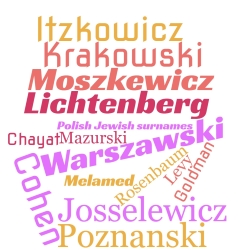Polish Americans constitute one of the largest Eastern European diasporas in the United States. As of the 2020 U.S. Census, approximately 8.6 million people reported Polish ancestry—about 2.6% of the total U.S. population—and around 2.7 million identified Polish as their sole ancestry. Including those claiming mixed heritage, the total number of Polish Americans approaches 10 million, according to historical and demographic estimates.
History of Polish American surnamesackgroundHistory of Polish American surnamesackground

Polish migration to the United States dates back over four centuries to the early Colonial period, with a handful of skilled craftsmen recorded in Jamestown in 1608 ebsco.com. However, the first major wave occurred between 1870 and 1914, driven by economic hardship and national political partitions. Estimates varied—from 50,000 in the early 1870s to over 2 million by 1900. During this period, many Polish peasants arrived seeking work in U.S. heavy industry, steel, railroads, and meatpacking, particularly in the Great Lakes region.[1]
Subsequent waves followed World War II and the political transformation of Poland in the late 20th century. By the mid-20th century, major Polish-American communities had formed in Chicago, New York, Detroit, and Milwaukee.[2]
Adaptation of Polish surnames in the USAAdaptation of Polish surnames in the USA
Orthographic adaptationOrthographic adaptation

One of the most visible changes in Polish surnames in the U.S. is orthographic simplification. Because the English alphabet lacks diacritic marks found in Polish (such as ą, ć, ł, ń, ó, ś, ź, ż), names were often transcribed without them. This process sometimes introduced confusion or led to phonetic distortions.[3]
Examples of changes due to diacritic omission include:
- Świątek → Swiatek
- Świątkowski → Swiatkowski
- Bąk → Bak
- Dzięba → Zieba
- Sokół → Sokol
- Krzyżanowski → Krzyzanowski
Such spellings obscure the original pronunciation and, in some cases, lead to semantic confusion. For example, names derived from święto ("holiday") were mistakenly linked to świat ("world") in English-language records.
Transliteration and contractionTransliteration and contraction
In order to maintain the Polish sound or identity of a surname within English phonology, some immigrants used transliteration or contracted forms. This practice helped preserve the heritage element while making names more practical in American contexts.
Examples:
Contracted Forms:
- Grzendzielski → Greenski (a hybrid: English root + Polish suffix)
- Kaczmarzewski → Kasmarski
- Maliszewski → Maleski
- Nowakowski → Novak
These reductions often shortened polysyllabic names to monosyllabic or disyllabic forms, sometimes retaining Polish recognition and sometimes becoming unrecognizable.
Semantic shift and hybridizationSemantic shift and hybridization
Sometimes, phonetic associations or spelling similarities led to unintended shifts in meaning:
These forms represent deeper assimilation, often resulting in surnames indistinguishable from English ones.
Initial letter retentionInitial letter retention
One notable phenomenon in name changes is the retention of the first letter or initial sounds from the original Polish name. This does not follow semantic or grammatical logic and may reflect psychological attachment to the "sound" of one's heritage name.
Examples include:
Gender forms and decline in feminine derivationGender forms and decline in feminine derivation
In contrast to American naming traditions, Polish surnames are gendered and sometimes indicate marital status. Feminine forms typically derive from masculine base names using suffixes like -ska, -ina, -owa, or -yna.
For example:
However, in the American context, such derivational distinctions have largely disappeared. Today, Polish-American women often use the masculine base form of the surname, reflecting both administrative simplicity and cultural convergence.
Polish American first names and cultural revivalPolish American first names and cultural revival
While many Polish immigrants adopted Anglo-American given names, a revival of Polish name-giving has occurred among second- and third-generation Polish Americans. This trend aligns with a broader reawakening of ethnic identity and pride.
It is not uncommon for American-born Polish parents to name their children with Anglo names officially, but use Polish diminutives or pet forms at home. For instance, a child named Michael might be affectionately called Michaś.
In rare cases, individuals retain Polish first names while adopting anglicized surnames (e.g., Zbigniew Dudek → Zbigniew Andersohn).
Most popular Polish American surnamesMost popular Polish American surnames
Celebrities with Polish American surnamesCelebrities with Polish American surnames

- Gwyneth Paltrow (Paltrowicz), actress
- Lana and Lily Wachowski, directors
- Jared Padalecki, actor
- Czesław Miłosz, Novel prize winning poet
- Tara Lipinski, figure skater
See alsoSee also
- Polish emigration
- Polish genealogy
- Polish surnames
- Belarusian surnames
- Lithuanian surnames
- Czech surnames
- Slovak surnames
- Ukrainian surnames
- Russian surnames
- Polish Jewish surnames
- German surnames
- Silesian surnames
- Latvian surnames
- Ashkenazi Jewish surnames
- Serbian surnames
- Bulgarian surnames
- Slovene surnames
- Croatian surnames
- Bulgarian surnames
- Bosnian surnames
- Macedonian surnames
- Ukrainian Canadian surnames
- Ukrainian American surnames
- American surnames
- Irish surnames
- French surnames
- Dutch surnames
Explore more about Polish American surnames:Explore more about Polish American surnames:
- Researching your Polish family history at MyHeritage
- Polish Historical Records at MyHeritage
- Poland family history records at MyHeritage
- A Foreigner's Guide to Polish surnames at Culture.pl
- 2020 Census results (USA)
References
- ↑ Bukowczyk, John J. (1986). And My Children Did Not Know Me: A History of the Polish-Americans. Bloomington: Indiana University Press.
- ↑ Brożek, Andrzej (1985). Polish Americans, 1854–1939. Translated by Worsztynowicz, Wojciech. Warsaw: Interpress.
- ↑ Lyra, Franciszek. “Polish Surnames in the United States.” American Speech 41, no. 1 (1966): 39–44. https://doi.org/10.2307/453242.

